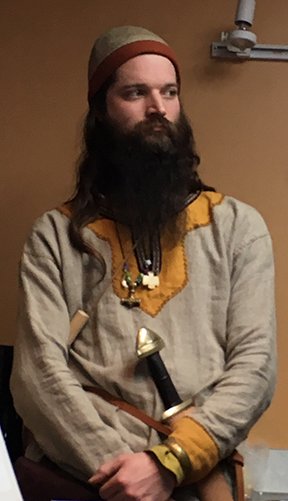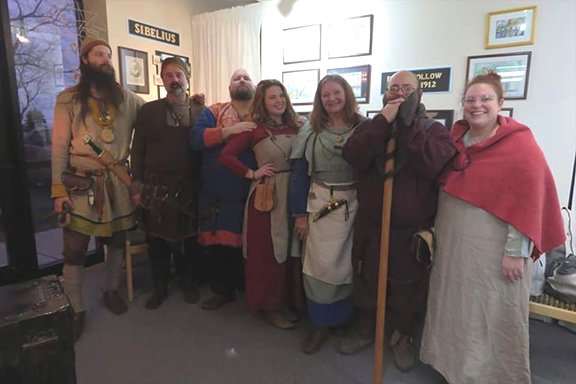Saturday 10am-3pm
Sharon Mackey, FHM Senior Staff Reporter

A picture containing person, wall, indoor, woman Description automatically generatedVikings – horned invaders raiding villages and towns in northern Europe, taking what they wanted from anyone in their way. This is what the Vikings were – uncivilized, unhygienic, raiders, right? Wrong. Most people today have a lot of misconceptions about who the Vikings were and how they behaved, as Finnish Heritage Museum members and guests discovered.
The Vikings of Vulksgaard is a group of Viking reenactors from Geneva, Ohio, who were welcome guests at the monthly meeting of the Finnish Heritage Museum in Fairport Harbor, Ohio, on February 10, 2020. Museum members Terttu and Tom Revolinsky and a number of other Viking participants dressed in costume and brought several tools and examples of Viking culture to the Museum. The leader of the group, Tristan Kuujanpaa, introduced his colleagues, who then explained about the Viking traditions and put to rest a lot of the myths about their culture. Looking very Viking-like is Justin Fiorelli to the left.
The Viking period was from about 790 AD when a monastery in Linda’s Farm was attacked by these invaders, to 1100 AD. The word Viking means pirate, or Scandinavian raider. The Vikings were the greatest military power in the years between the Roman Empire and the Army of the Crusaders. They contributed to literature, art, poetry, and broadened trade. Technology, then as it does today, allowed the Vikings to be successful in life, prosper and expand over the Nordic countries. But they could not depend solely on their technology – boats, tools, weapons, etc. These things could be copied. Success depended more on social organization, communication, and trade networks.
he Norse way of life was mostly an agriculture-based society, along with raising both dairy cattle and sheep. Reindeer were raised for their hide which was used for clothing; it provided much needed warmth. Old Norse was spoken, or some derivative of it. Finnish was not part of this language or culture. The Vikings were leery of the Finnish people, especially the women. The Finns would put hollowed out skulls in the trees along the rivers to scare the Vikings away. They wanted little or nothing to do with the “traders and raiders” known as the Vikings. Tom commented that the Viking way of cooking was very bland and in that respect was very similar to Finnish cooking. Pictured below, left to right: Tom Revolinsky, Terttu Kangas Revolinsky, and Viking Chieftain Tristin Kujanpaa.

The Vikings are considered the first melting pot of peoples. They raided other countries and captured or encouraged the slaves to join their group. Life was to be lived to the limit. This society relied on raiders, farmers, and storytellers. Women were considered the equal to or even the leaders of the Vikings. For that time period, the people were extremely clean. They bathed at least once a week, used bone combs, kept their hair clean and pulled back. Women expected the men to keep clean. If a man was not clean, the woman had the right to divorce him. Some of the women even fought in battle as warriors, but most stayed home to run the farm and take care of the family.
Two types of ships were used by the Vikings – the Long Ship and the Knarr. The latter was used for trading and moving up inland rivers, the Long Ship was the fighting ship. The Viking tools had a dual purpose – used both for fighting and in everyday living. The most common weapon/tool was an axe. Swords and armor had no purpose other than warfare and belonged to professional raiders and warriors. Iron and steel were very expensive to acquire, and thus used in small amounts on the warriors’ shields. These shields were carried in one hand and the sword in the other. The group demonstrated how each warrior overlapped his shield with the shield of the warrior next to him to form a formidable line of attack or defense. Is it any wonder they ruled the Nordic countries for 500 years? Pictured below are the “Vulksgaard Vikings: Left to Right: Justin Fiorelli, Tom Revolinsky, Tristin Kujanpaa, Sigrid Seidkona, Terttu Revolinsky, Shane Starlin and last is Kelly Lynn.

At the conclusion of the program, tools and weapons were passed among the spectators, who also then had a chance to ask questions. This was another great program brought to us by Program Chair, Anne Pohto.
After all the questions had been answered, refreshments were served and the business meeting was called to order by Museum President, Lasse Hiltunen. Check out our upcoming programs on our website: finnishheritagemuseum.org. Our hours are also posted on the site; if you are in the area, we hope you will stop in.

